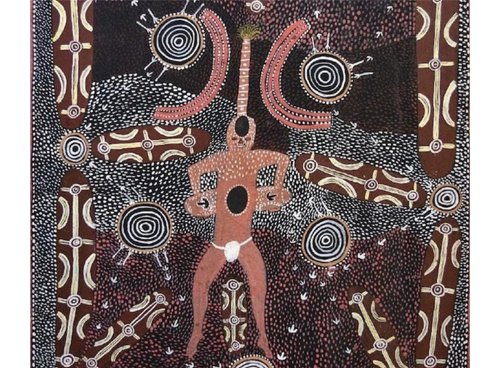
NEW YORK — Aboriginal art — a term typically used to describe works made by the indigenous people of Australia — takes several forms, all intriguing. They range from body paint and bark paintings to rock art; ochre paintings using organic pigments; textiles; wood carvings; and paintings on canvas, linen or wood. Paintings, in particular, have become one of the most desirable forms of Aboriginal art to collect and are widely represented in museums and fine collections around the world.
In Australia, the tradition of Aboriginal art has been passed down in families. Among the most celebrated artistic lineages is that of Clifford Possum Tjapaltjarri (1926-2003), who often painted stories from his culture and his traditional bush upbringing. He rooted these stories firmly amid the Australian landscape where he was raised. His inclusion of Aboriginal iconography in his paintings, which are free of any European influences, speaks to how this art movement developed on its own.
“In doing so, Clifford, as well as the other artists involved with the Papunya Tula Movement, helped to develop the true definition of Aboriginal art, an art revolving around a culture, the Jukurrpa,” according to the website of the Kate Owen Gallery in Australia.
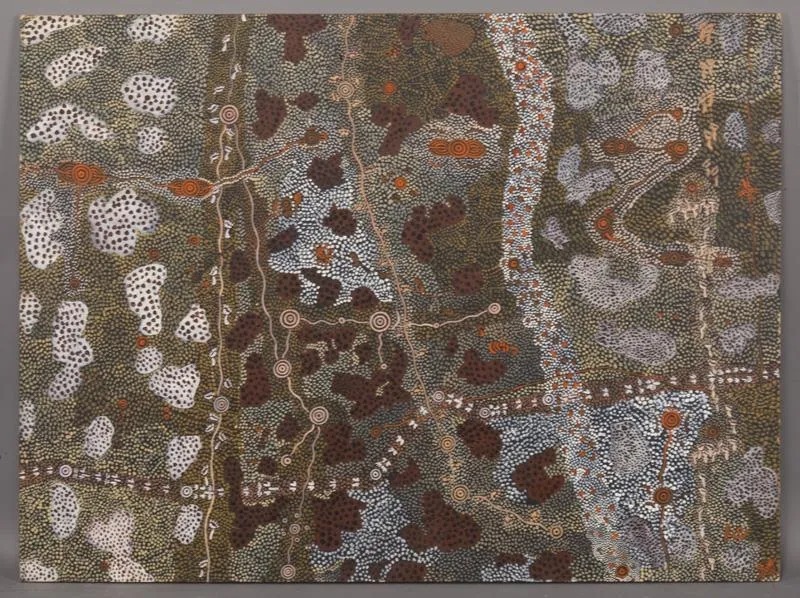
Utilizing several typical Aboriginal art techniques, including spirals and dots, an untitled circa-1973 painting from his Artist’s Stories series sold for $75,000 plus the buyer’s premium in November 2019 at Dallas Auction Gallery. While Possum’s work can be described as contemporary, it is assuredly Aboriginal in its nature and its inspiration. The viewer not only can appreciate the artist’s skill in the balance of color and composition but also the mythological references contained within that provide a visual guide to the Aboriginal culture.
The Aboriginal people who live in what is now Australia have long believed that the earth and everything that formed or grew on it, from the grass to the rocks, was the work of their ancestral spirits. They referred to this as Dreamtime or the Dreaming period, a time when these spirits came down from the sky and walked on the earth, sculpting the landscape with rivers, deserts and plantings.
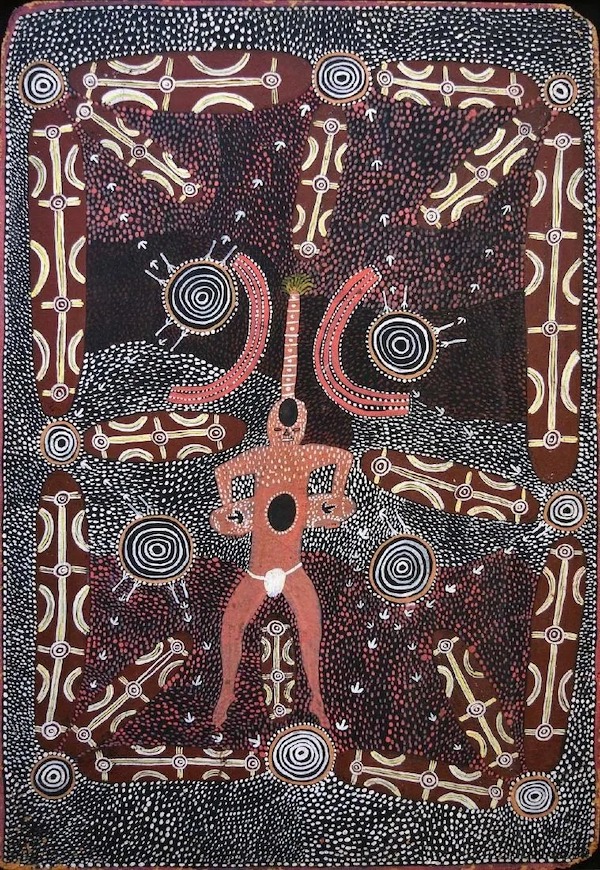
A Tim Leura Tjapaltjarri painting laden with symbolism and hidden meanings, which depicts an emu dreaming, realized $65,140 plus the buyer’s premium in November 2018. Image courtesy of Cooee Art and LiveAuctioneers.
Many Aboriginal artists paint Dreaming imagery, including Tim Leura Tjapaltjarri (1930-1984), who was a close cousin of Clifford Possum, having grown up in the same house as him. The two explored similar themes in their respective artworks, but in different ways. An important and early painting by Leura, laden with symbolism, depicted an emu dreaming. It realized $65,140 plus the buyer’s premium in November 2018 at Cooee Art. Painted in February 1972, this work is among several in which the artist created graphic elements, iconography and motifs that Possum later worked on in his own paintings.
Another fine example of an Aboriginal artist exploring ancestral motifs is Water Dreaming by Johnny Warangkula Tjupurrula (1925-2001), an abstract composition that brought $37,500 plus the buyer’s premium in May 2022 at Selkirk Auctioneers & Appraisers. Warangkula was raised in the bush without European influences. After working in manual labor for years, he turned to art after meeting Geoffrey Bardon, who began teaching school in 1971 in Papunya, a remote Aboriginal settlement. Bardon is widely credited for encouraging the desert art movement there and introducing it to the world.
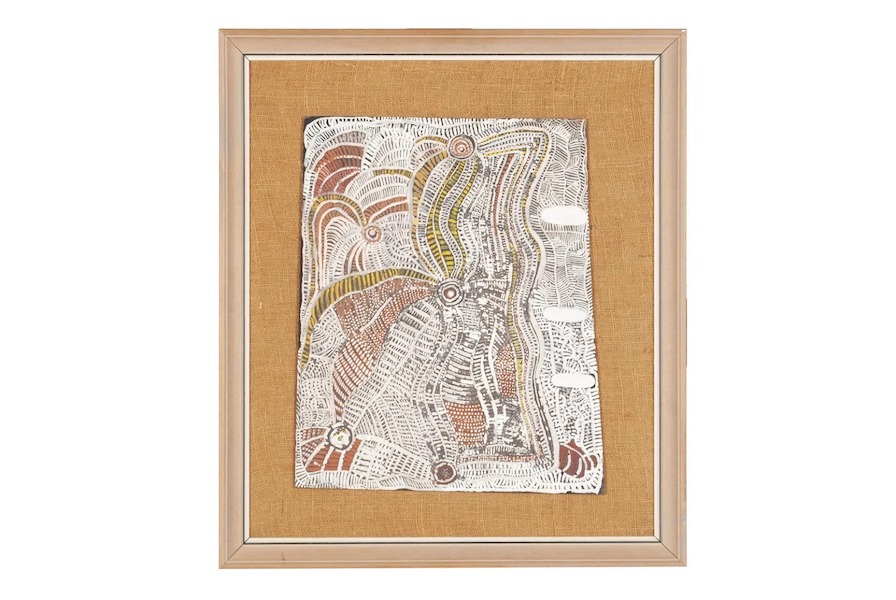
‘Water Dreaming’ by Johnny Warangkula Tjupurrula attained $37,500 plus the buyer’s premium in May 2022. Image courtesy of Selkirk Auctioneers & Appraisers and LiveAuctioneers.
Dots, said to possibly represent energy auras, are a common motif in Aboriginal art. Warangkula’s style came to be known as overdotting; he stacked layers of dots to represent his dreams. The auction catalog notes for Water Dreaming state that “Tight organization of bands and lines, hatching and dot embellishment give his work a powerful, energetic visual strength.”
Body paint is one of the oldest forms of Aboriginal art. Typically, it saw ceremonial use among women, but the tradition has transcended its origins and made its way onto the canvas. Several notable Aboriginal painters have taken an artwork form once used on bodies to create artworks that are deeply rooted in their heritage and possess a timeless, modern feel. A triptych by Emily Kame Kngwarreye (1910-1996), Ochre Body Paint, sold for $19,000 plus the buyer’s premium in July 2022 at Abell Auction. Kngwarreye, one of the most renowned Aboriginal artists in the region, embarked on a series of highly personal paintings in the late 1980s that quickly attracted the attention of art dealers and collectors from near and afar. She painted this work in 1995 in the Utopia region in the Northern Territory, north of Alice Springs, using acrylic paint and natural ochres.
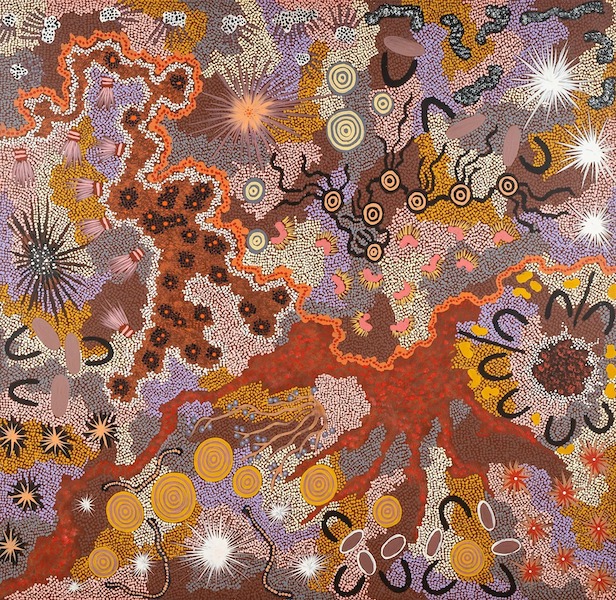
Taught how to paint by her father, Clifford, while still very young, Gabriella Possum Nungurrayi (b. 1967-) has become a well-known painter in her own right. Her painting on canvas Hunting for Food earned $2,500 plus the buyer’s premium in July 2022 at Abell Auction, and demand for her works has been increasing. While the influence of her father can be seen in her paintings, she has developed her own distinctive style and is known for her colorful and striking compositions.
Aboriginal works hold a distinctive position in the realm of art produced by indigeous peoples. It is admired and sought-after for its ability to connect the artist — and viewer — to the land and its rich and ancient cultural traditions.


